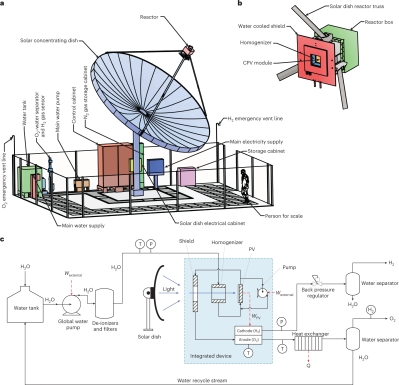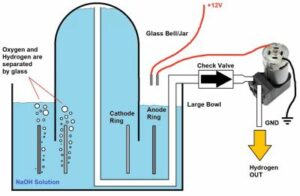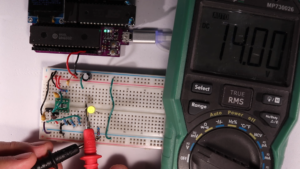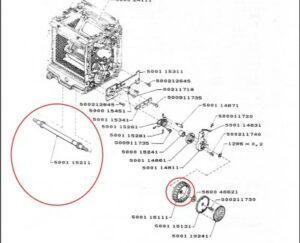Hydrogen is a useful gas. Whether you want to float an airship, fuel a truck, or heat an industrial process, hydrogen can do the job. However, producing it is currently a fraught issue. While it can be produced cleanly using renewable energy, it’s often much cheaper to split it out of hydrocarbon fuels using processes that generate significant pollution.
There are methods to generate hydrogen more efficiently, though, in a clean and sustainable process. that also produces useful heat and oxygen as byproducts. The key to the process? Concentrated sunshine.
Solar Split
A diagram of the system along with its concomitant process diagram. Credit:
” data-medium-file=”https://platoaistream.com/wp-content/uploads/2023/04/making-hydrogen-with-solar-energy-with-oxygen-and-heat-a-bonus.jpg” data-large-file=”https://platoaistream.com/wp-content/uploads/2023/04/making-hydrogen-with-solar-energy-with-oxygen-and-heat-a-bonus-1.jpg?w=649″ decoding=”async” loading=”lazy” class=”size-medium wp-image-586808″ src=”https://platoaistream.com/wp-content/uploads/2023/04/making-hydrogen-with-solar-energy-with-oxygen-and-heat-a-bonus.jpg” alt width=”400″ height=”385″ srcset=”https://platoaistream.com/wp-content/uploads/2023/04/making-hydrogen-with-solar-energy-with-oxygen-and-heat-a-bonus-1.jpg 2167w, https://platoaistream.com/wp-content/uploads/2023/04/making-hydrogen-with-solar-energy-with-oxygen-and-heat-a-bonus-1.jpg?resize=250,241 250w, https://platoaistream.com/wp-content/uploads/2023/04/making-hydrogen-with-solar-energy-with-oxygen-and-heat-a-bonus-1.jpg?resize=400,385 400w, https://platoaistream.com/wp-content/uploads/2023/04/making-hydrogen-with-solar-energy-with-oxygen-and-heat-a-bonus-1.jpg?resize=649,625 649w, https://platoaistream.com/wp-content/uploads/2023/04/making-hydrogen-with-solar-energy-with-oxygen-and-heat-a-bonus-1.jpg?resize=1536,1479 1536w, https://platoaistream.com/wp-content/uploads/2023/04/making-hydrogen-with-solar-energy-with-oxygen-and-heat-a-bonus-1.jpg?resize=2048,1971 2048w” sizes=”(max-width: 400px) 100vw, 400px”>
Hydrogen touted as a clean fuel of the future, by virtue of the fact it can be burned or used to make electricity with minimal to no emissions. It’s touted as a potential fuel for cars, trucks, trains, planes, and even construction equipment. However, while the hydrogen itself is clean, generating it often isn’t. The race is on to find a clean method of producing hydrogen at scale, with researchers investigating everything from nanoparticles to advanced pyrolytic processes. Whenever you hear people talking about “green hydrogen,” this is what they mean: hydrogen produced without any nasty greenhouse emissions.
With an eye to producing exquisitely clean hydrogen. researchers have demonstrated a pilot plant on the kilowatt-scale using solar hydrolysis technology, as per a paper published in Nature. The system runs on municipal tap water, which is run through multiple particulate filters and deionizers to prepare it for the reactor. Inside the reactor, the deionized water is heated by light captured by a 7-meter diameter parabolic mirrored dish, which acts as a concentrator to maximise the solar energy that reaches the reactor. This light not only heats the water, but also reaches a photovoltaic panel which provides energy to run the PEM electrolysis cell, which is what actually splits the water into hydrogen and oxygen.
The key to the system is the double-purposing of the solar energy input. The most basic idea is to simply use solar energy from a photovoltaic system to power a PEM electrolysis cell. In this case, though, the solar energy is also used to heat the water which drastically improves the performance of the electrochemical process.
A holistic approach also maximises the economic value generated by the system. Waste heat from the system is captured with a heat exchanger where it could be used for a variety of external heating purposes. Additionally, the system doesn’t just output hydrogen, but oxygen as well. While this isn’t directly useful as a fuel, it’s still useful for a wide variety of industrial and medical applications.
The pilot plant produces roughly half a kilogram of hydrogen per day. That’s enough to power a single hydrogen car for a European racking up fairly average annual mileage. Alternatively, such an installation could provide roughly half the electrical demand and over half the annual heat demand of an average Swiss household. Realistically, though, straight photovoltaic solar would be far simpler in this instance.
The solar concentrator tracks the sun in two axes to make the absolute best of the solar energy available. Credit: EPFL, Youtube
” data-medium-file=”https://platoaistream.com/wp-content/uploads/2023/04/making-hydrogen-with-solar-energy-with-oxygen-and-heat-a-bonus.png” data-large-file=”https://platoaistream.com/wp-content/uploads/2023/04/making-hydrogen-with-solar-energy-with-oxygen-and-heat-a-bonus-1.png?w=800″ decoding=”async” loading=”lazy” class=”size-medium wp-image-586809″ src=”https://platoaistream.com/wp-content/uploads/2023/04/making-hydrogen-with-solar-energy-with-oxygen-and-heat-a-bonus.png” alt width=”400″ height=”225″ srcset=”https://platoaistream.com/wp-content/uploads/2023/04/making-hydrogen-with-solar-energy-with-oxygen-and-heat-a-bonus-1.png 1280w, https://platoaistream.com/wp-content/uploads/2023/04/making-hydrogen-with-solar-energy-with-oxygen-and-heat-a-bonus-1.png?resize=250,141 250w, https://platoaistream.com/wp-content/uploads/2023/04/making-hydrogen-with-solar-energy-with-oxygen-and-heat-a-bonus-1.png?resize=400,225 400w, https://platoaistream.com/wp-content/uploads/2023/04/making-hydrogen-with-solar-energy-with-oxygen-and-heat-a-bonus-1.png?resize=800,450 800w” sizes=”(max-width: 400px) 100vw, 400px”>
Plans are already in place to build a larger system at the multi-hundred-kilowatt scale, which will produce hydrogen for use in a Swiss metal production plant. It will also supply oxygen for medical use and deliver hot water for use at the factory.
Incidentally, if you’re interested in designing your own similar system, help is at hand. The École Polytechnique Fédérale de Lausanne (EPFL) has released the Solar PhotoElectroChemical Device Optimization tool, or SPECDO for short. Essentially, it’s a web page full of calculators that determine the performance parameters of a given solar hydrogen generator. You’ll need to be pretty nifty with your engineering though, and find a way to source an effective PEM electrolyser for your design.
If hydrogen does become a mainstream fuel of the future, solar photochemical processes to make it efficiently will be key. There’s no point in spending huge sums of money to convert transport and industry over to hydrogen fuel if we produce it in a way that still creates greenhouse gas emissions, after all. At the same time, this research shows that hydrogen still isn’t a silver-bullet solution to all our problems. It requires significant engineering and finesse to come out cleaner than the fuels it’s intended to replace.
- SEO Powered Content & PR Distribution. Get Amplified Today.
- PlatoAiStream. Web3 Data Intelligence. Knowledge Amplified. Access Here.
- Minting the Future w Adryenn Ashley. Access Here.
- Source: https://hackaday.com/2023/04/27/making-hydrogen-with-solar-energy-with-oxygen-and-heat-a-bonus/
- :has
- :is
- :not
- :where
- $UP
- 1
- 2023
- a
- About
- Absolute
- acts
- actually
- Additionally
- After
- All
- along
- already
- also
- an
- and
- annual
- any
- applications
- approach
- ARE
- AS
- At
- available
- average
- AXES
- basic
- BE
- become
- BEST
- Bonus
- build
- burned
- but
- by
- CAN
- car
- case
- cheaper
- come
- content
- convert
- could
- creates
- credit
- Currently
- day
- deliver
- Demand
- demonstrated
- Design
- designing
- Determine
- device
- directly
- do
- does
- Doesn’t
- drastically
- Economic
- economic value
- Effective
- efficiently
- electricity
- embedded
- Emissions
- energy
- Engineering
- enough
- equipment
- essentially
- Ether (ETH)
- European
- Even
- everything
- external
- eye
- factory
- fairly
- filters
- Find
- Finesse
- Float
- For
- from
- Fuel
- fuels
- full
- future
- GAS
- generate
- generated
- generating
- generator
- given
- greenhouse gas
- Greenhouse gas emissions
- Half
- hand
- Have
- hear
- help
- holistic
- HOT
- household
- However
- HTTPS
- huge
- hydrogen
- Hydrogen Fuel
- idea
- if
- improves
- in
- industrial
- industry
- input
- installation
- instance
- interested
- into
- issue
- IT
- ITS
- itself
- Job
- just
- Key
- larger
- light
- Mainstream
- make
- Making
- max-width
- mean
- medical
- Medical Applications
- metal
- method
- methods
- minimal
- money
- more
- most
- much
- multiple
- municipal
- Nature
- Need
- Nifty
- no
- of
- often
- on
- only
- optimization
- or
- our
- out
- output
- over
- own
- Oxygen
- page
- panel
- Paper
- parabolic
- parameters
- People
- performance
- pilot
- Place
- plato
- Plato Data Intelligence
- PlatoData
- Point
- Pollution
- potential
- power
- Prepare
- pretty
- problems
- process
- processes
- produce
- Produced
- Production
- provide
- provides
- published
- purposes
- Race
- Reaches
- released
- Renewable
- renewable energy
- replace
- requires
- research
- researchers
- roughly
- Run
- same
- Scale
- Short
- Shows
- significant
- similar
- simply
- single
- solar
- solar energy
- solution
- Source
- Spending
- split
- Splits
- Still
- straight
- such
- Sun
- sunshine
- supply
- sustainable
- Swiss
- system
- talking
- Tap
- Technology
- than
- that
- The
- The Future
- they
- this
- Through
- time
- to
- tool
- touted
- transport
- truck
- true
- two
- use
- used
- using
- value
- variety
- want
- Waste
- Water
- Way..
- we
- web
- webp
- WELL
- What
- whenever
- whether
- which
- while
- wide
- will
- with
- without
- would
- you
- Your
- youtube
- zephyrnet













